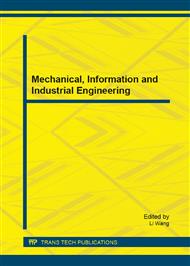p.672
p.676
p.680
p.684
p.688
p.692
p.696
p.702
p.706
Research on the Anti-Collision Techniques of Radio Frequency Network of Pasture
Abstract:
To study the problem of the identification of multiple ear tags of cattle occur data collision in the RFID network of pasture, the experiment use an improved anti-collision algorithm, it is combined bit locking with dynamic and analysis method, only colliding bits are processed by the method of binary, during transmission the data are dynamic, only send known information, which receive complementary bits of the known information, and then analyze the performance of the algorithm and simulation. The results show that compare with traditional binary algorithm, the improved algorithm from the operating frequency, transmission delay, data throughput have obvious advantages, the improved algorithm that could solve the problem of data collision cause by the cattle those wear ear tags get into radio frequency region, improve the efficiency of the tag identification.
Info:
Periodical:
Pages:
688-691
Citation:
Online since:
March 2015
Authors:
Price:
Сopyright:
© 2015 Trans Tech Publications Ltd. All Rights Reserved
Share:
Citation:


